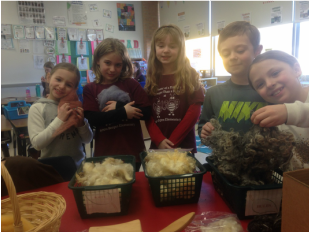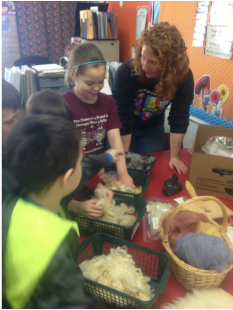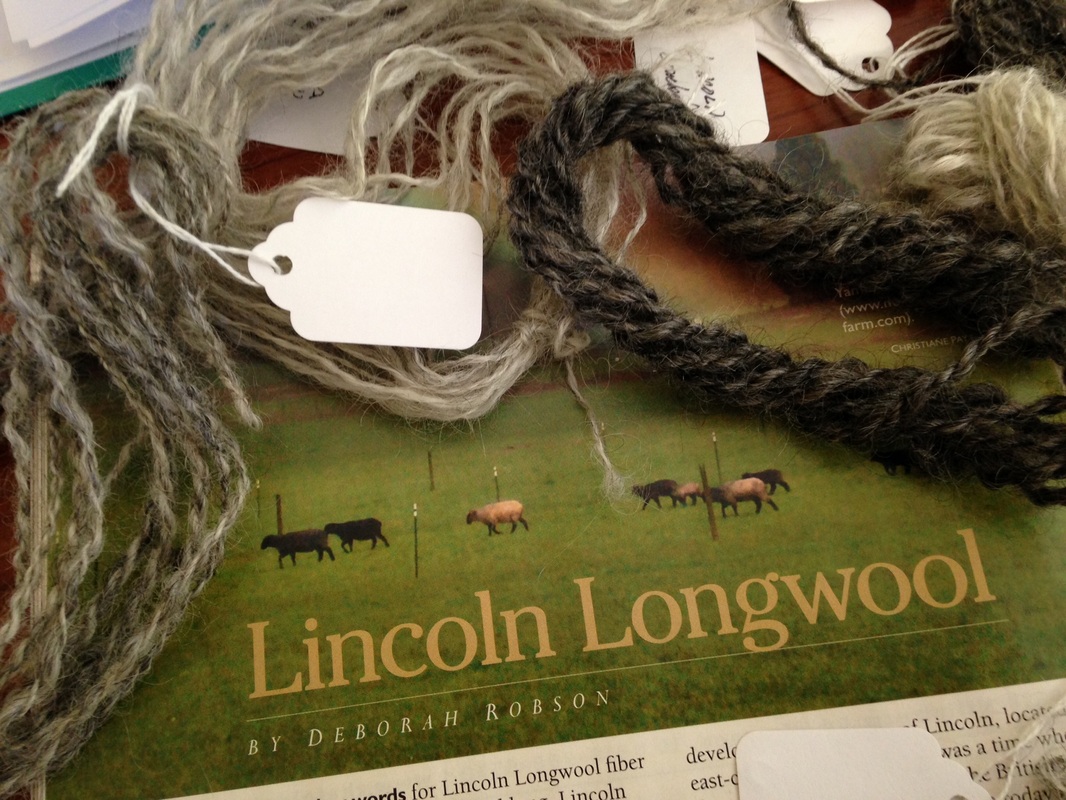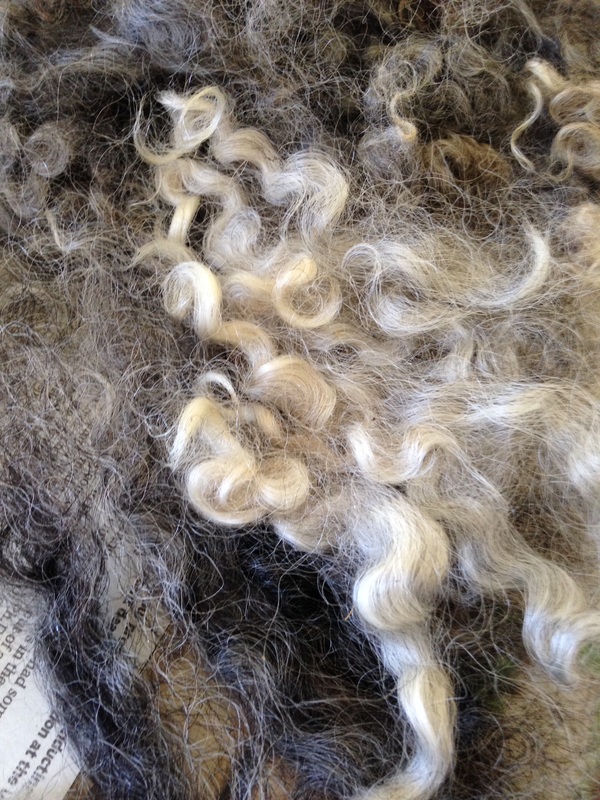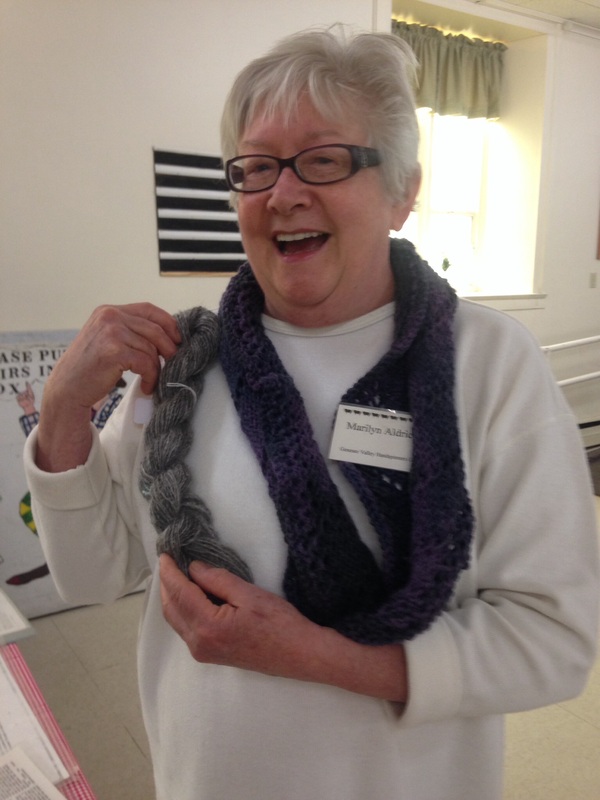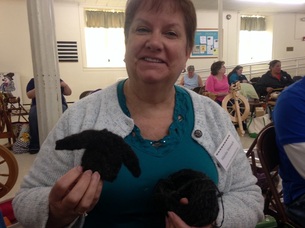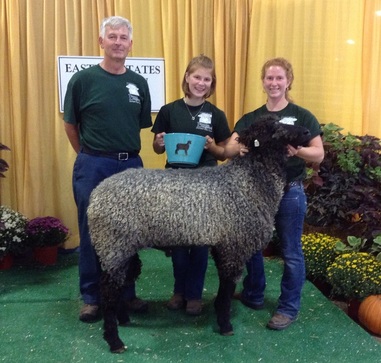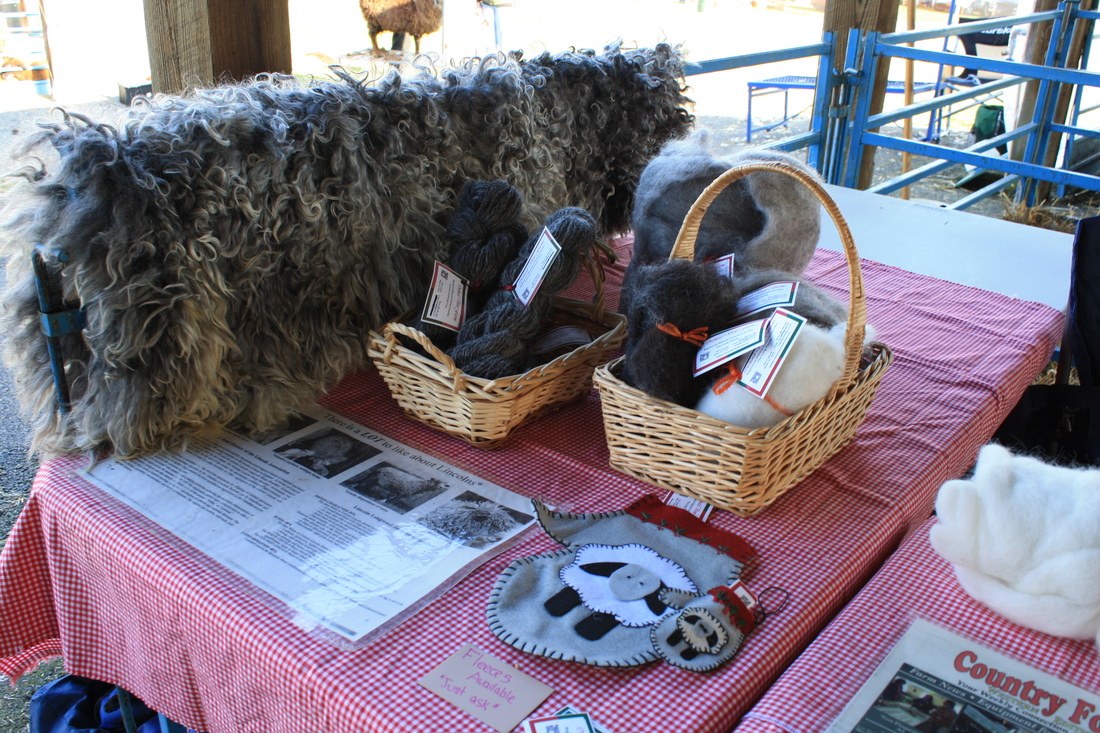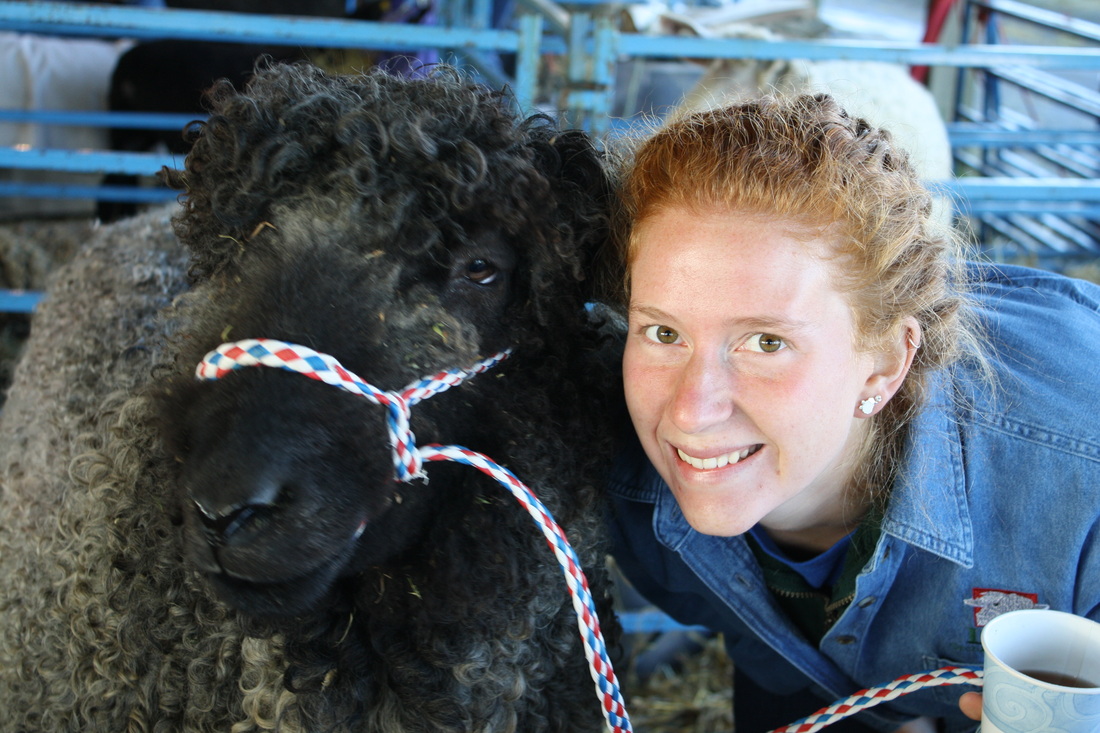|
It's been quite a while since I've updated you all about what's been happening at Orchard View! Starting a job, still finishing my graduate work, and purchasing a house have all left very little excess time. March 16th-19th was Ag Literacy Week in New York. This week is sponsored by New York Agriculture in the Classroom and each year, a book is chosen to be read in elementary schools across the state. The books are chosen to be very educational; no talking animals, representative of the topic, teach a practical lesson, etc. The reading of the book is accompanied by hands-on activities for the kids. I was very excited last year when I found that this year's book was going to be "Weaving the Rainbow" by George Ella Lyon. This book goes over the process of shearing sheep to weaving. 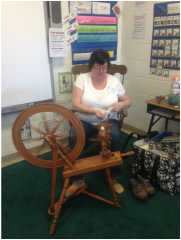 If you read my blog or follow my Facebook, you know how passionate I am about sheep and wool, and educating others about those two things, so you can only imagine my excitement! Now that I'm back home living in western NY, I got in contact with my local Cooperative Extension office to become a volunteer. I was even more excited when I found out that I'd have the opportunity to read at the elementary school I attended as a kid. We planned four different stations for the kids to rotate through: 1. Reading of the book 2. Learning about fleece- hands on fleece feeling, spinning demonstration, crochet demonstration 3. Hands-on making of a felted ball 4. Meet bottle baby lambs I got in contact with Diane who owns/operates Acorn Works Fiber Processing, a local fiber processing business, to help with the spinning demonstration, and I donated a Lincoln fleece. Another local sheep farm, Maple Lawn Farm, provided the lambs for the afternoon. I was a part of the "learning about fleece" room. Diane brought her spinning wheel and demonstrated spinning. She conveniently also had some of my wool spun up, so I could show kids a finished product! An extension employee gave a crochet demonstration and had different types of yarn and finished products like hats and scarves to see and feel. I brought in some of my raw Lincoln Longwool wool, Diane brought some Merino and Romney wool, and we also had crossbred meat-breed wool to use for a fleece discussion, which was the part that I ran. The kids rotated through each of the three stations in our classroom and I had 10 minutes to talk about the process of shearing and steps to make wool become yarn. I started by discussing the difference between the different types of wool, and used an analogy of different dog breeds to discuss why the wool from different sheep looked and felt different from each other. I then had them feel the four different fleeces and pick out their favorite. Hands-down my Lincoln fleece was the favorite of the day (if you need another reason to buy my fleeces, just trust the 2nd graders! haha), and they really didn't like the feel of the meat breed wool. I then had them smell the fleece, to which the response was a lot of "ewwww"s and scrunched noses (again, they all agreed mine smelled the best). We talked about the process of washing and then showed a set of carders to talk about how the wool is "combed". Next, the kids got to feel the roving and we discussed the process of dying. Finally, we talked about how the roving becomes yarn by way of Diane's spinning demonstration. This event was a lot of fun! The kids asked wonderful questions like how the shears work to cut the wool off and whether it hurts the sheep, and why the wool felt "sticky", which led to great discussions about lanolin. They definitely learned a lot throughout the afternoon, and it really demonstrated the importance of agricultural education in today's school system, where most kids have no idea what happen on farms. A big thanks to New York Ag in the Classroom for planning, Battenkill Fiber Mill for donating time & resources to make the roving, and Genesee County Cooperative Extension for coordinating the event locally. Events like these happen throughout the state for Ag Literacy Week and volunteers spend a lot of time getting the books and corresponding materials (like the wool & roving samples) sent around the state, so thank you to everyone!
1 Comment
Back in May, I had someone from the Clotho's Handspinners group in Richmond, Virginia ask for a fleece to use for a Rare Breeds Workshop. I was thrilled that they asked me, as I love to share the Lincoln Breed with others! It's also encouraging that many groups are investigating different breeds of sheep (see the previous blog post about the Genesee Valley Spinner's Guild sheep study back in the spring!). I met with members of the group at the Maryland Sheep and Wool Festival back in May (which yes, I still have to post pictures of...) and they shared with me photos of the Rare Breeds Workshop that was held this past weekend. I absolutely love seeing what is being done with my wool, so if you have previously purchased some of my wool, please share with me what you've done! Here are some of the awesome photos from their workshop. To see the full album visit: http://www.pinterest.com/jlhinkes/rare-breeds-longwool-spinning-workshop/ Thank you Becky for contacting me, and also Judy for the photos. Lincoln Longwool handspun samples
Goodness I am WAY behind in keeping you all updated with our farm happenings... It's been a crazy time of the year with lambing, finishing up this semester of graduate school at Cornell, and everything else that happens when the world wakes up in the spring. Last month in April, I had the pleasure of attending the Genesee Valley Handspinner's Guild (http://www.gvhg.org/) meeting to participate in their current "sheep study". Each month, members of the guild receive a small sample of a different breed of sheep so they can learn about breeds, textures, and discover new types of sheep. In March, we supplied the guild with some of our Lincoln lamb wool, and I wanted to attend the meeting to see what members thought of our wool and what they did with it. The results were pretty impressive, as you can tell from the photos below! While I don't spin, being a member of the guild will hopefully serve as a way to promote not only our business, but our breed and I look forward to being involved in the future. Maybe they'll even teach me how to spin one day! People always ask me how I got interested in Lincolns, and "why sheep" in general. The first question is a much easier one to answer, and a story for another day. For the second question, the answer is not so clear. The easy answer is that I was born loving sheep. Seriously. My first stuffed animals were sheep, which was obviously not my choice, but my favorite animal has always been sheep. When my mom was seven months pregnant with me, my parents visited the Empire Spring Classic Sheep Show, and we think that's where it happened...
Anyway, for my entire life, I have loved and wanted sheep, and apparently was up for doing anything to convince my parents that we should get them. My dad reminded me of a persuasive essay I wrote in Mrs. Wallace's forth grade class and thought I would share it with you all. It must have been a good essay, because three years later I got my first sheep! Enjoy! A friend of mine recently once encouraged me to "try something that scares you every day". Well that something for me this past week was learning how to wash my own sheep fleece. Washing the wool is one of the first steps to processing it, and the main purpose is to get rid of the lanolin and organic matter. Lanolin is the oil naturally produced by sheep to keep the wool clean, act as a moisturizer and help shed water. Lanolin accounts for anywhere between 5-25% of the raw wool weight. I previously have had wool washed by several local businesses, and the price ranges from $4-8.00 per pound. We have been sending 50lbs or more at a time to have it processed into yarn, blankets and roving, so I thought I would investigate the process to see if it is worth doing myself. I have been nervous to try it for fear of felting (or otherwise ruining) the wool. Since I have been home on break from school with a barn full of freshly shorn fleeces, I figured I would give it a try. Below is the process I used, which I found on Spinderella's Wool Mill website. I have modified some of their instructions, which I will try to describe in my processes. If any of you are wool washing veterans and have suggestions for improvement, please let me know. 1. We sheared the middle of December (see previous post), and during shearing, we try to make sure we are separating out manure tags, belly wool, etc. in the barn to reduce the amount of skirting to be done in the house. Even still, I spent over 30min. on each fleece, picking through it, discarding organic matter and undesirable wool before starting the wash process. I usually did this the night before so I could get started with washing first thing in the morning. 2. The website calls for water up to 150 degrees. Our tap water didn't get that hot (until we turned up the thermostat), so for the first couple attempts, I was boiling water on the stove and dumping it in the machine... not exactly quick, but it worked. Once you fill a washing machine full of hot water, you dump in detergent (I used Dawn), stir in to not create suds, and add the fiber handful by handful. The fiber then sits in the hot water for 20 min. The article mentioned adding salt to the water, but our water is soft and our fleeces are not extremely dirty, so I did not bother with this. I also used less detergent (2/3 - 3/4 cup instead of 1 whole cup). 3. After the fleece sat for 20min. in the hot, soapy water, I lifted it out into the sink next to the washer. I then drained the dirty water and refilled with hot water and soap to repeat Step 1 for a total of 2 washes. The second wash I let sit for 15-18min. instead of 20min. I don't really think the time makes much of a difference. The first couple times I actually spun out the water as the article mentioned. Since then, I have not done this and lifted out the fleece to reduce the amount of agitation. I also ruined two fleeces by felting during this stage because I accidently left the washer on before the spin step. 4. Next, I conducted 3 rinses using the same method: Fill up the washer with warm water, add the fleece by the handful, and then lifted out after a few minutes. On the 3rd rinse, I actually let the washer spin out the water and the fleece to get a lot of the water out to assist with the drying process. The article mentions putting baking soda and vinegar in one of the last rinses, but I didn't find that necessary because the water was very clear by the 3rd rinse. 5. After spinning out, I laid a tarp out by our wood stove in the living room, and spread the fleece out. Throughout the day, I would fluff up the fleece, turn it over, and pick out large pieces of organic matter still left in the wool. It was actually amazing to see how much chaff still came out while it was drying! Our cat really loved laying in the wool! (as you can see by the photo above!). After ruining 2 fleeces, I was feeling a bit discouraged, but someone said I was paying too much attention to the little details of doing it right, and to not worry about the temperature of the water, measuring the detergent exactly, timing the soaks, etc. It took me 2-2.5 hours per fleece, as I was taking my time lifting out the wool and placing it back in the water each time. I have since washed 5 fleeces successfully and will continue to make this a winter project! Four of the fleeces will be going to Finger Lakes Woolen Mill to be made into roving, the fifth will probably get made into yarn. Only about 10 more to go... haha Again, any input to speed up the process or personal experience would be appreciated. :)
It occurred to me as I went to write this post, that I never updated you on how we did at the Big E! If you've been following our facebook page, you'll know that we won Best Fleeced Natural Colored Lincoln for the second year in a row! This year is was an especially awesome honor because it was the National show. We were very excited. Check out the picture below of Benny, our yearling ram. He is a bit (major understatement) feisty and never wants to set up, so sorry for the poor example of confirmation! Now, onto our last show of the year. We just returned this evening from the New York State Sheep and Wool Festival in Rhinebeck, NY. It is our last show of the year, and one of our favorites. The weather is always beautiful with the leaves changing and crisp weather (much nicer than showing in humid July!). We brought 6 sheep this year and had fun as usual. This show is always so nice because the festival goers are always so interested in what you are doing and ask a lot of good questions. Education is one of my favorite parts about raising Lincolns and going to shows, so I particularly enjoy talking to people.
We did fairly well in the show this year, not first, but not last either! We got second in the pair of ewe lambs, and third overall in the flock which was excellent! This show is always challenging because they show by type of wool instead of breed, so we show against Romneys, Border Leisters, etc. The thing we did best with this weekend is wool sales! Sold both of our pelts, a couple blankets, and lots of roving and yarn. We definitely will be placing more orders for yarn, blankets, and maybe even socks (I'll keep you posted on that!). If you would like a blanket, speak now while we still have them in stock! Next up on our farm schedule... shearing in December and lambing in Jan./Feb.! Winter is on its way.  I just wanted to notify everyone of a great educational event coming up this month at Cornell University. Previously, Cornell has annually held the NY Sheep and Goat Symposium in October. For reasons I'm not sure of, this event will not be happening this year, but will be replaced by the "Cornell Sheep and Goat Management Day". This will be a one day event located at Morrison Hall and the Livestock Pavilion on the Cornell University Campus in Ithaca. The date is Saturday, September 21st, with an optional evening program Friday, September 20th. Friday will begin with a cheesemaking workshop, Goat/Sheep bowl for youth, and "Basic Health and Management for Goats and Sheep", taught by Dr. Michael Thonney who is the sheep professor at Cornell. Saturday will have three different tracts geared towards 1) the 12 year-old and under crowd, 2) the teen crowd, 3) adults. I highly encourage anyone who is involved in goats and sheep (especially 4-H members) to attend. Not only are the workshops going to be taught by the NY experts on sheep and goats, but it is a great networking event as well! Also, if you know of anyone who would be interested in this event, please spread the word. To find out more about this event, registration, lodging, ect. visit: http://www.sheep.cornell.edu/calendar/index.html eWe will unfortunately not be in attendance that weekend due to the National Lincoln Show at the Big E in Springfield, Mass. but hope some of you will be able to go! It's great that it is just one day. |
AuthorEmmaline Long, main owner of Orchard View Farm, has a passion for Lincoln sheep and loves educating others about her breed and farm, She currently serves as the Vice President of the National Lincoln Breeders Association. Archives
October 2020
Categories
All
|
Orchard View Lincoln Longwools7617 S. Lake Rd., Bergen NY 14416 |
Contact UsStay Up-To-DateFollow our blog!
|


